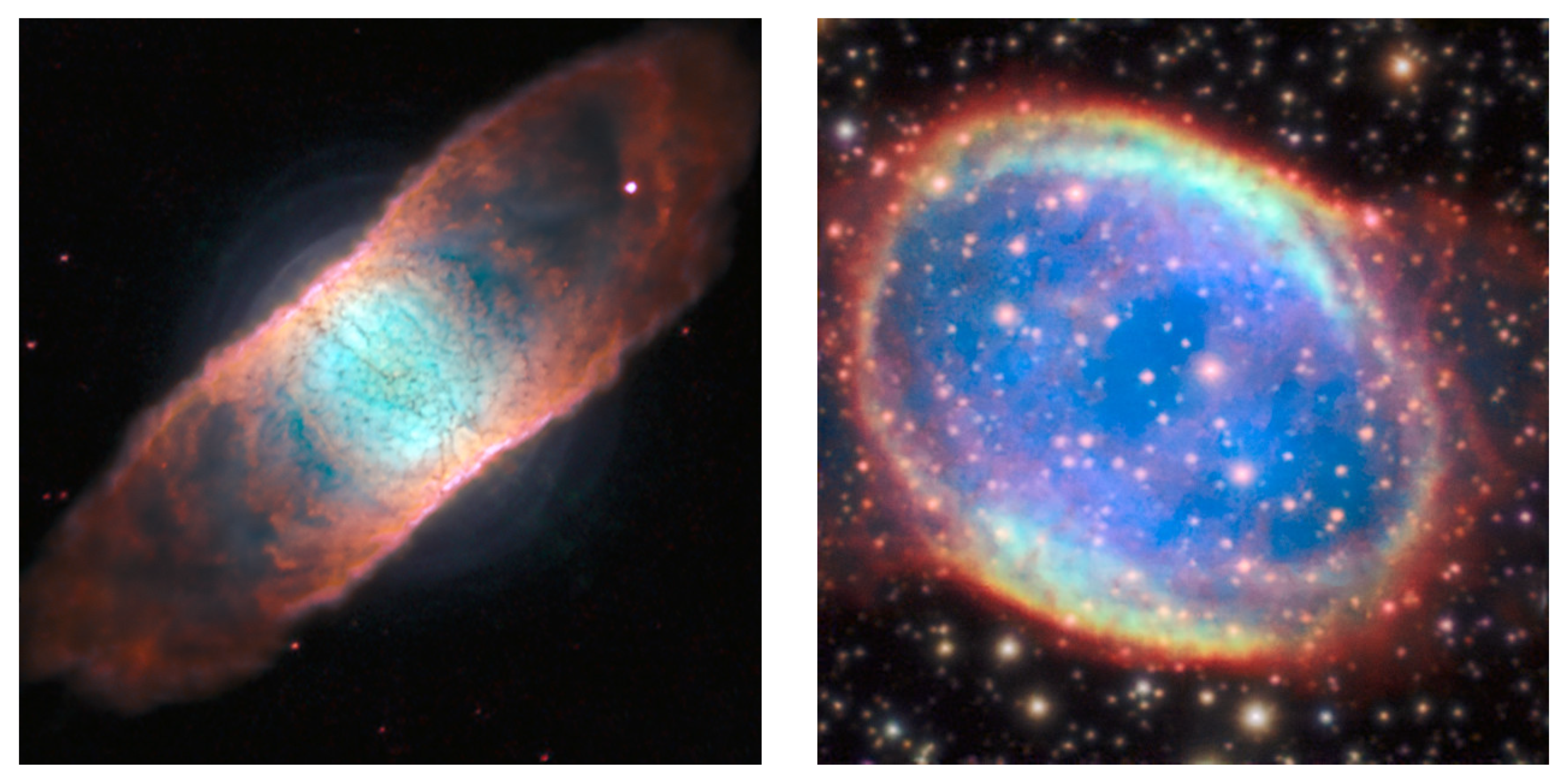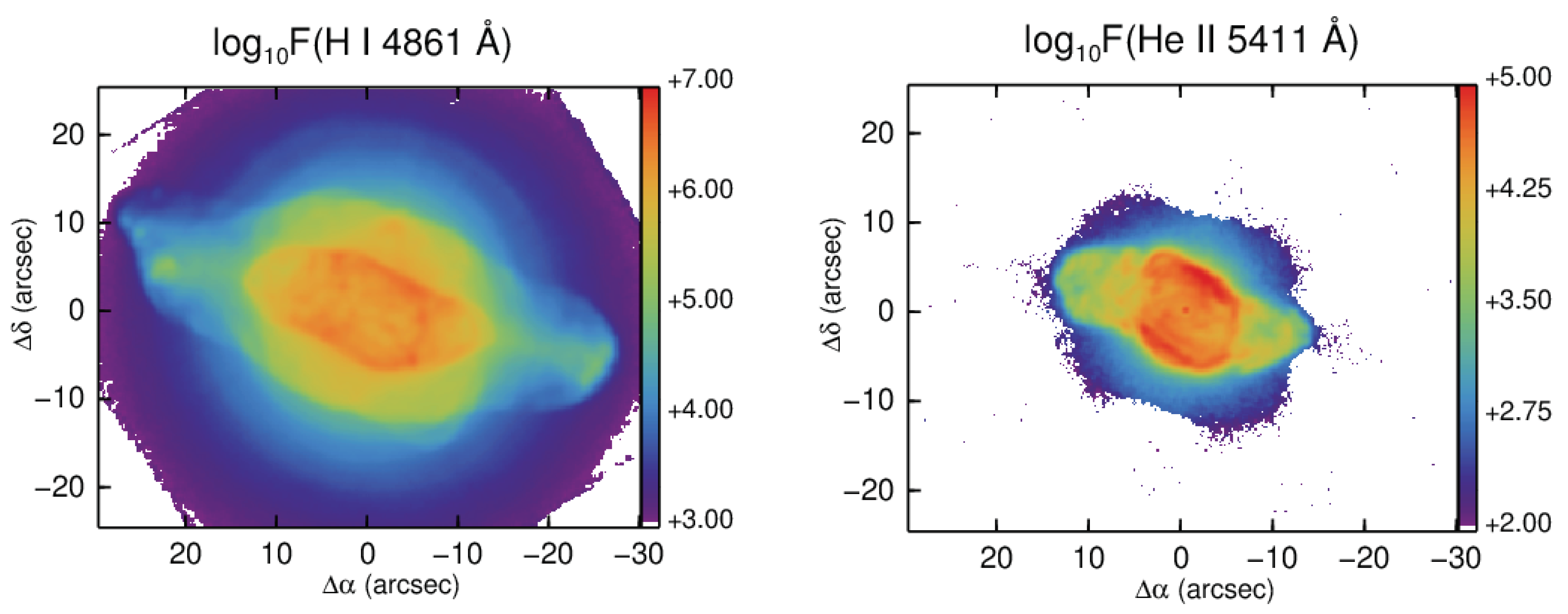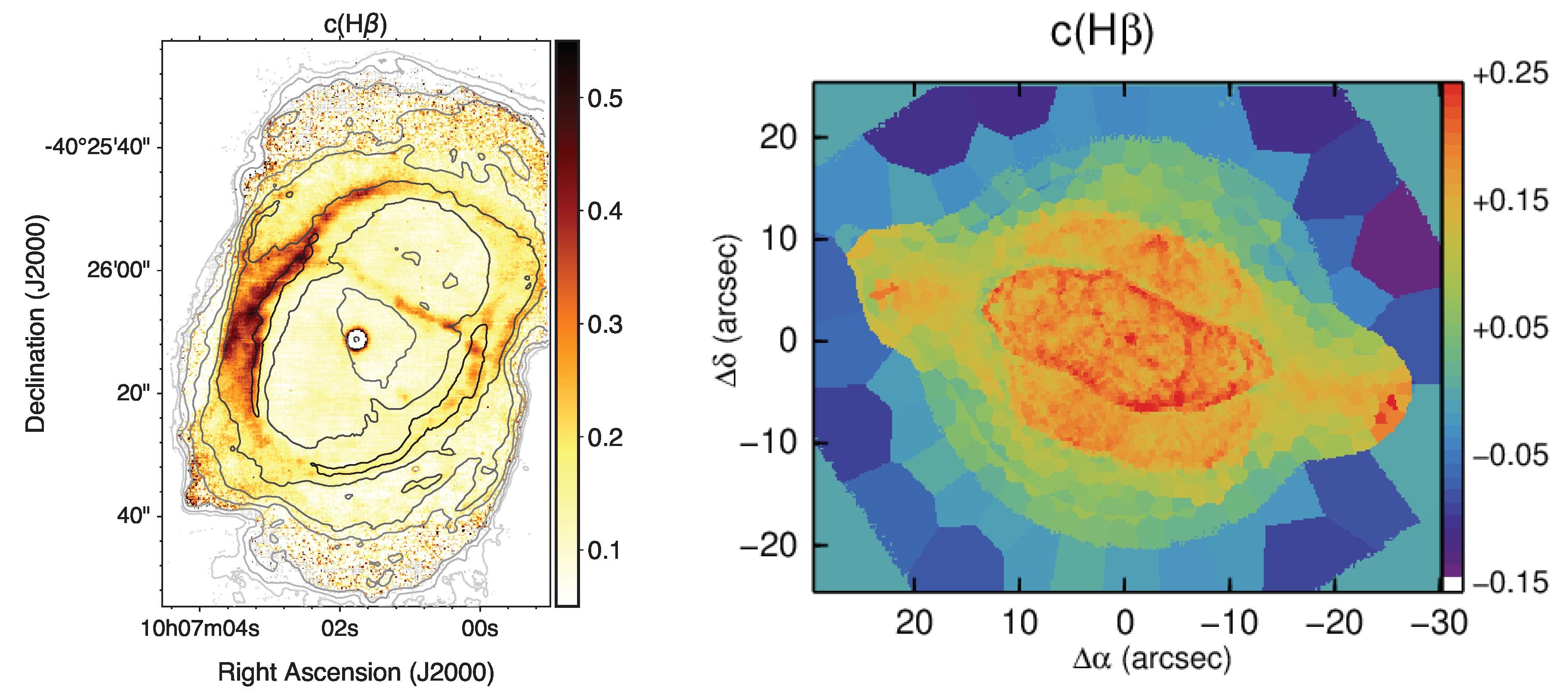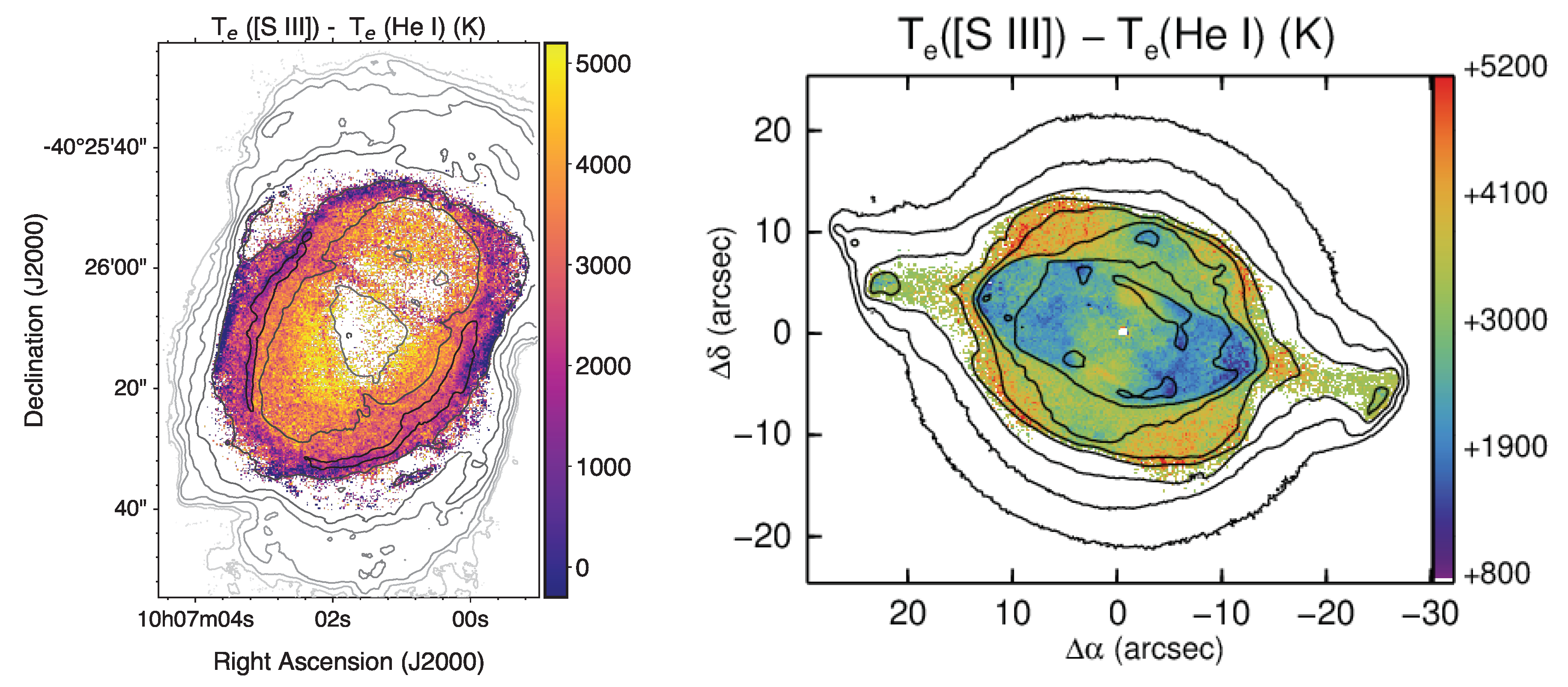Integral Field Spectroscopy of Planetary Nebulae with MUSE
Abstract
:1. Overview of MUSE
2. Suitability of MUSE for PNe
- the spectral Resolving power (R) is relatively low (∼1800–3600; see Table 1), thus not sampling the emission lines at the optimal value of two times their intrinsic (thermal and Doppler broadened) width (R > 10,000). On multiple sampled spectra, some restoration is of course possible to assess line blends below 3–4Å separation;
- Important diagnostic lines blueward of 4650Å are not included, including the [O II] doublet (3726,3729Å) for measurement, [Ne III] lines, and the auroral [O III]4363Å, which, by the ratio to the [O III]4959,5007Å lines, provides for the higher ionization medium. Alternative, less bright diagnostic lines are available in the MUSE range, involving less major coolants of the gas, such as from [S II] 6716/6731Å, [Cl III] 5517/5537Å, and [Ar IV] 4711/4740Å in extended mode, from [O I] 6302/5577Å, [N II] 6583/5755Å, [S III] 9069/6311Å, and [Ar III] 7135/5192Å, thus partially compensating for the absence of the “classical” O diagnostic, which samples the bulk ionization component for all but the lowest ionization PNe;
- The bright and important (at least for higher ionization PNe) He II 4686Å line is missing from the MUSE normal mode (but included in extended mode). This absence is partially compensated by the He II 5411Å line, although ∼10 times fainter;
- The [O II]7319,7320Å and 7329,7330Å doublet is much fainter than the blue [O II]3726,3729Å lines, but can be used for the determination of the O ionic fraction;
- Relatively few Optical metal Recombination Lines (ORLs) are covered in normal mode (mostly N), and while the 4650Å region important for the brightest O II recombination lines is just included in extended mode, no Ne ORLs are available.
3. Archival MUSE Observations of PNe
4. MUSE Mapping of NGC 3132 and NGC 7009
4.1. Spectral Analysis: Line Ratios
- reddening from a ratio of H to H (and also Paschen lines in the red, such as P10 (9015Å) and P9 (9229Å)) compared to Case B (nebula optically thick to HILyman- photons; [14]);
- dereddened line maps (in absolute flux) for all measured lines;
- from the [S III]6312/9068Å ratio, [N II]5755/6583Å and [O I]5577/6302Å for most spaxels, and from [Ar III]5192/7135Å in brighter regions (PyNeb [15] was used for nebular diagnostic computations);
- from [Cl III]5517/5537Å and [S II]6716/6731Å;
- from He I line ratios together with 3889Å optical depth;
- from the ratio among the high series Paschen lines;
- from the magnitude of the Paschen jump at 8210Å with respect to HI P11 (8863Å) line strength;
- ionic abundances of many species using the appropriate , diagnostics, such as O and O, S and S, and Ar and Ar;
- total abundances of He and O.
- The logarithmic extinction maps, c(H), show distinct features over the nebulae pointing to the presence of dust within the ionized regions (see Figure 3 and [16]). Whilst not unexpected, since some evidence of spatial extinction has been observed in the optical for a few PNe to date and dust emission detectable in the infrared is almost ubiquitous (e.g., [17]), the association of dust with distinct features of the nebular structure, such as shell edges, knots, etc., is noteworthy;
- measured from the ratio of He I lines, or from the magnitude of the Paschen continuum jump at 8210Å, can be compared with the Collisionally Excited Line (CEL) from the [S III] line ratio, to determine a CEL to recombination line temperature difference. In both NGC 7009 and NGC 3132, the difference in increases towards the central star (see Figure 4). The radial trend of this increase is in the same sense as the increase of the Abundance Discrepancy Factor (ADF) measured between ORL and CEL abundances, for example for O [18], although not yet in the same nebulae;
- The maps of total O abundance (i.e., O/H), derived on various assumptions of Ionization Correction Factor (ICF) to correct for the fact that [O IV] emission is not observed in the optical, is not flat for NGC 3132 or NGC 7009 ([12,13], as would be expected from evolutionary considerations (short-term alterations in O are not predicted in the late stages of low mass star evolution). The deviations from flatness in the O/H maps imply that the ICF procedure is incomplete: Figure 13 for NGC 3132 [13] and 21 for NGC 7009 [12] demonstrate that these O abundance modulations are correlated with the main shells and/or ionization zones.
4.2. Spectral Analysis: Radial Velocities
5. Prospects
Author Contributions
Funding
Acknowledgments
Conflicts of Interest
References
- Bacon, R.; Accardo, M.; Adjali, L.; Anwand, H.; Bauer, S.; Biswas, I.; Blaizot, J.; Boudon, D.; Brau-Nogue, S.; Brinchmann, J.; et al. The MUSE second-generation VLT instrument. Soc. Photo-Opt. Instrum. Eng. SPIE Conf. Ser. 2010, 7735, 773508. [Google Scholar] [CrossRef]
- Richard, J.; Bacon, R. MUSE User Manual, Version 9.1; ESO: Garching, Germany, 2019. [Google Scholar]
- Dopita, M.A.; Ali, A.; Sutherland, R.S.; Nicholls, D.C.; Amer, M.A. IFU spectroscopy of southern planetary nebulae IV: A physical model for IC 418. Mon. Not. R. Astron. Soc. 2017, 470, 839–864. [Google Scholar] [CrossRef] [Green Version]
- Fang, X.; Liu, X.W. Very deep spectroscopy of the bright Saturn nebula NGC 7009—I. Observations and plasma diagnostics. Mon. Not. R. Astron. Soc. 2011, 415, 181–198. [Google Scholar] [CrossRef] [Green Version]
- Fang, X.; Liu, X.W. Very deep spectroscopy of the bright Saturn nebula NGC 7009—II. Analysis of the rich optical recombination spectrum. Mon. Not. R. Astron. Soc. 2013, 429, 2791–2851. [Google Scholar] [CrossRef]
- García-Rojas, J.; Madonna, S.; Luridiana, V.; Sterling, N.C.; Morisset, C.; Delgado-Inglada, G.; Toribio San Cipriano, L. s-process enrichment in the planetary nebula NGC 3918. Results from deep echelle spectrophotometry. Mon. Not. R. Astron. Soc. 2015, 452, 2606–2640. [Google Scholar] [CrossRef] [Green Version]
- Zhang, Y.; Liu, X.W.; Wesson, R.; Storey, P.J.; Liu, Y.; Danziger, I.J. Electron temperatures and densities of planetary nebulae determined from the nebular hydrogen recombination spectrum and temperature and density variations. Mon. Not. R. Astron. Soc. 2004, 351, 935–955. [Google Scholar] [CrossRef] [Green Version]
- Peimbert, M.; Torres-Peimbert, S. Type I planetary nebulae. In Planetary Nebulae; Aller, L.H., Ed.; IAU Symposium; Reidel: Dordrecht, The Netherlands, 1983; Volume 103, pp. 233–242. [Google Scholar]
- Cox, P.; Huggins, P.J.; Bachiller, R.; Forveille, T. CO in the southern planetary nebulae NGC 6072, NGC 6563, and IC 4406. Astron. Astrophys. 1991, 250, 533. [Google Scholar]
- Balick, B.; Alexander, J.; Hajian, A.R.; Terzian, Y.; Perinotto, M.; Patriarchi, P. FLIERs and Other Microstructures in Planetary Nebulae. IV. Images of Elliptical PNs from the Hubble Space Telescope. Astron. J. 1998, 116, 360–371. [Google Scholar] [CrossRef]
- Ciardullo, R.; Bond, H.E.; Sipior, M.S.; Fullton, L.K.; Zhang, C.Y.; Schaefer, K.G. A HUBBLE SPACE TELESCOPE Survey for Resolved Companions of Planetary Nebula Nuclei. Astron. Astrophys. 1999, 118, 488–508. [Google Scholar] [CrossRef] [Green Version]
- Walsh, J.R.; Monreal-Ibero, A.; Barlow, M.J.; Ueta, T.; Wesson, R.; Zijlstra, A.A.; Kimeswenger, S.; Leal-Ferreira, M.L.; Otsuka, M. An imaging spectroscopic survey of the planetary nebula NGC 7009 with MUSE. Astron. Astrophys. 2018, 620, A169. [Google Scholar] [CrossRef] [Green Version]
- Monreal-Ibero, A.; Walsh, J.R. The MUSE view of the planetary nebula NGC 3132. Astron. Astrophys. 2020, 634, A47. [Google Scholar] [CrossRef]
- Osterbrock, D.E.; Ferland, G.J. Astrophysics of Gaseous Nebulae and Active Galactic Nuclei; University Science Books: Sausalito, CA, USA, 2006. [Google Scholar]
- Luridiana, V.; Morisset, C.; Shaw, R.A. PyNeb: A new tool for analyzing emission lines. I. Code description and validation of results. Astron. Astrophys. 2015, 573, A42. [Google Scholar] [CrossRef]
- Walsh, J.R.; Monreal-Ibero, A.; Barlow, M.J.; Ueta, T.; Wesson, R.; Zijlstra, A.A. The extinction and dust-to-gas structure of the planetary nebula NGC 7009 observed with MUSE. Astron. Astrophys. 2016, 588, A106. [Google Scholar] [CrossRef] [Green Version]
- Bernard-Salas, J. Infrared spectroscopy of planetary nebulae, including Spitzer. In Planetary Nebulae in our Galaxy and Beyond; Barlow, M.J., Méndez, R.H., Eds.; IAU Symposium; Cambridge University Press: Cambridge, UK, 2006; Volume 234, pp. 181–188. [Google Scholar] [CrossRef]
- Wesson, R.; Jones, D.; García-Rojas, J.; Boffin, H.M.J.; Corradi, R.L.M. Confirmation of the link between central star binarity and extreme abundance discrepancy factors in planetary nebulae. Mon. Not. R. Astron. Soc. 2018, 480, 4589–4613. [Google Scholar] [CrossRef]
- Monteiro, H.; Morisset, C.; Gruenwald, R.; Viegas, S.M. Morphology and Kinematics of Planetary Nebulae. II. A Diabolo Model for NGC 3132. Astrophys. J. 2000, 537, 853–860. [Google Scholar] [CrossRef] [Green Version]
- Richard, J.; Bacon, R.; Blaizot, J.; Boissier, S.; Boselli, A.; Bouché, N.; Brinchmann, J.; Castro, N.; Ciesla, L.; Crowther, P. BlueMUSE: Project Overview and Science Cases. arXiv 2019, arXiv:1906.01657. [Google Scholar]




| Mode | Field () | Pixel () | Image Quality |
|---|---|---|---|
| Wide Field Mode (WFM) | 59.9 × 60.0 | 0.20 | Native seeing |
| Wide Field Mode + AO | 59.9 × 60.0 | 0.20 | 2× encircled energy |
| Narrow Field Mode (NFM) | 7.42 × 7.43 | 0.025 | 55–80 milli-arcseconds |
| Spectral mode | Wavelength range (Å) | Resolving power | Field mode |
| Normal (N) | 4800–9300 | 1770–3590 | WFM |
| Normal (N) | 4800–5780, 6050–9300 | 1740–3450 | NFM |
| Extended (E) | 4650–9300 | 1770–3590 | WFM |
| Extended (E) | 4650–5760, 6010–9300 | 1740–3450 | NFM |
| Target | Designation | MUSE Mode | Obs.Type | Notes |
|---|---|---|---|---|
| NGC 6369 | PNG002.4 +05.8 | WFM AO, N | Comm. | |
| M 1-42 | PNG 002.7 −04.8 | WFM, E | GO | ESO Proposal 097.D-0241 |
| Hf 2-2 | PNG 005.1 −08.9 | WFM, E | GO | 097.D-0241 |
| GJJC 1 | PNG 009.8 −07.5 | NFM, N | Comm. | IRAS 18333-2357 |
| Sa 3-151 | PNG 033.2 −01.9 | NFM, N | Comm. | |
| NGC 6778 | PNG 034.5 −06.7 | WFM AO, N | Comm. | |
| NGC 7009 | PNG 037.7 −34.5 | WFM, N | SV | Walsh et al. (2016,2018) |
| NGC 7009 | PNG 037.7 −34.5 | WFM, E | GO | 097.D-0241 |
| NGC 7009 | PNG 037.7 −34.5 | NFM, N | Comm. | |
| Abell 46 | PNG 055.4 +16.0 | WFM, E | GO | 097.D-0241 |
| IC 418 | PNG 215.2 −24.2 | WFM, N | Comm. | |
| NGC 3242 | PNG 261.0 +32.0 | WFM, E | GO | 097.D-0241 |
| NGC 2818 | PNG 261.9 +08.5 | WFM, N | Comm. | |
| NGC 3132 | PNG 272.1 +12.3 | WFM, N | Comm. | Monreal-Ibero and Walsh (2020) |
| IC 2501 | PNG 281.0 −05.6 | WFM, N | Comm. | |
| NGC 4361 | PNG 294.1 +43.6 | WFM, N | Comm. | |
| NGC 5189 | PNG 307.2 −03.4 | WFM, N | Comm. | |
| IC 4406 | PNG 319.6 +15.7 | WFM, N | Comm. | Type I PN; see Figure 1 |
| Mz-3 | PNG 331.7 −01.0 | NFM, N | Comm. | |
| CPD-56 8032 | PNG 332.9 −09.9 | NFM, N | Comm. | He 3-1333 |
| NGC 6153 | PNG 341.8 +05.4 | WFM, E | GO | 097.D-0241 |
| NGC 6563 | PNG 358.5 −07.3 | WFM AO, N | Comm. | See Figure 1 |
© 2020 by the authors. Licensee MDPI, Basel, Switzerland. This article is an open access article distributed under the terms and conditions of the Creative Commons Attribution (CC BY) license (http://creativecommons.org/licenses/by/4.0/).
Share and Cite
Walsh, J.R.; Monreal-Ibero, A. Integral Field Spectroscopy of Planetary Nebulae with MUSE. Galaxies 2020, 8, 31. https://doi.org/10.3390/galaxies8020031
Walsh JR, Monreal-Ibero A. Integral Field Spectroscopy of Planetary Nebulae with MUSE. Galaxies. 2020; 8(2):31. https://doi.org/10.3390/galaxies8020031
Chicago/Turabian StyleWalsh, Jeremy R., and Ana Monreal-Ibero. 2020. "Integral Field Spectroscopy of Planetary Nebulae with MUSE" Galaxies 8, no. 2: 31. https://doi.org/10.3390/galaxies8020031
APA StyleWalsh, J. R., & Monreal-Ibero, A. (2020). Integral Field Spectroscopy of Planetary Nebulae with MUSE. Galaxies, 8(2), 31. https://doi.org/10.3390/galaxies8020031





